Development of 1.3 GHz Medium-β (β = 0.634) Disk-Loaded Deflecting Cavity for 150 keV Electron Beam
Abstract
:1. Introduction
2. Deflecting Cavity Design
2.1. Microwave Design and Particle Tracking
2.2. Power Coupling for Operation
2.3. Mode Separation
2.4. Particle Tracking Simulation
3. Mechanical Design
3.1. Analysis of the Frequency Drift during Pumping
3.2. Brazing Solution
3.3. Tuning Holes Design
4. Thermodynamic Analysis
5. Fabrication and RF Measurement Results
6. Conclusions
Author Contributions
Funding
Institutional Review Board Statement
Informed Consent Statement
Data Availability Statement
Acknowledgments
Conflicts of Interest
References
- Bernd, S.; Sara, C.; Peter, S.; Stefan, S.; Manfred, T.; Axel, W.; Timo, K.; Thomas, S.; Volker, S.; Hans, S.; et al. Bunch Length Measurements at the SLS Linac Using Electro Optical Sampling. In Proceedings of the Free Electron Laser Conference, Trieste, Italy, 29 August–3 September 2004. [Google Scholar]
- Xuan, W.; Shouhua, N.; Hyuk, P.; Junjie, L.; Rick, C.; Renkai, L.; Xijie, W.; Jianming, C. Measurement of femtosecond electron pulse length and the temporal broadening due to space charge. Rev. Sci. Instrum. 2009, 80, 013902. [Google Scholar]
- Baum, P.; Zewail, A. Breaking resolution limits in ultrafast electron diffraction and microscopy. Proc. Natl. Acad. Sci. USA 2006, 103, 16105–16110. [Google Scholar] [CrossRef] [PubMed]
- Takao, I. High-resolution bunch-length monitor capable of measuring an rms value of a few mm. Nucl. Instrum. Methods A 1995, 361, 430–435. [Google Scholar]
- Wang, D.X.; Krafft, G.A.; Sinclair, C.K. Measurement of femtosecond electron bunches using a rf zero-phasing method. Phys. Rev. E 1998, 57, 2283–2286. [Google Scholar] [CrossRef]
- Gao, M.; Jean-Ruel, H.; Cooney, R.; Stampe, J.; de Jong, M.; Harb, M.; Sciaini, G.; Moriena, G.; Miller, R. Full characterization of RF compressed femtosecond electron pulses using ponderomotive scattering. Opt. Express 2012, 20, 12048–12058. [Google Scholar] [CrossRef] [PubMed]
- Shi, J.; Chen, H.; Tang, C.; Huang, W.; Du, Y.; Zheng, S.; Ren, L. RF deflecting cavity for bunch length measurement in Tsinghua Thomson scattering X-ray source. Chin. Phys. C 2009, 33, 161–164. [Google Scholar]
- Dolgashev, V.; Bowden, G.; Ding, Y.; Emma, P.; Krejcik, P.; Lewandowski, J.; Limborg, C.; Litos, M.; Wang, J.; Xiang, D. Design and application of multimegawatt X-band deflectors for femtosecond electron beam diagnostics. Phys. Rev. ST Accel. Beams 2014, 17, 102801. [Google Scholar] [CrossRef]
- Maesaka, M.; Inoue, S.; Ohshima, T.; Matsubara, S.; Higashiya, A.; Yabashi, M.; Shintake, T.; Otake, Y.; Ego, H.; Yanagida, K.; et al. Beam diagnostic system of XFEL/Spring-8. In Proceedings of the DIPAC’09, Basel, Switzerland, 25–27 May 2009. [Google Scholar]
- Craievich, P.; Bopp, M.; Braun, H.; Ganter, R.; Pedrozzi, M.; Prat, E.; Reiche, S.; Zennaro, R.; Grudiev, A.; Catalan, L.N.; et al. Sub-Femtosecond Time-Resolved Measurements Based on a Variable Polarization X-Band Transverse Deflecting Structures for SwissFEL. In Proceedings of the Free Electron Laser Conference, Santa Fe, NM, USA, 20–25 August 2017. [Google Scholar]
- Tan, J.; Gu, Q.; Fang, W.; Tong, D.; Zhao, Z. X-band deflecting cavity design for ultra-short bunch length measurement of SXFEL at SINAP. Nucl. Sci. Tech. 2014, 25, 060101. [Google Scholar]
- Sergey, B.; Ivan, B.; Valery, S.; John, S.; Karl, S.; Vadim, V. Deflecting cavity for beam diagnostics at Cornell ERL injector. Nucl. Instrum. Methods A 2014, 614, 179–183. [Google Scholar]
- McKenzie, J. Longitudinal Beam Characterisation on VELA Using a Transverse Deflecting Cavity. Ph.D. Thesis, University of Liverpool, Liverpool, UK, 2018. [Google Scholar]
- Nishimura, Y.; Sakaue, K.; Nishiyama, M.; Takahashi, T.; Washio, M.; Takatomi, T.; Urakawa, J. Design of a two-cell rf-deflector cavity for ultra-short electron bunch measurement. Nucl. Instrum. Methods A 2014, 764, 291–298. [Google Scholar] [CrossRef]
- Lin, X.; Zha, H.; Shi, J.; Zhou, L.; Liu, S.; Gao, J.; Chen, H. Development of a seven-cell S-band standing-wave RF-deflecting cavity for Tsinghua Thomson scattering X-ray source. Nucl. Sci. Tech. 2021, 32, 36. [Google Scholar] [CrossRef]
- Sunjeong, P.; Hyun, W.; Mi, H.; Young, C.; In, H.; Kyu-Ha, J.; Eun-San, K.; Hongjoo, K.; Nikolay, A.; Young, U.; et al. Measurement of low-energy and low-charge ultrashort bunches using an S-band RF deflector. Nucl. Instrum. Methods A 2019, 927, 194–201. [Google Scholar]
- van Oudheusden, T.; Pasmans, P.L.E.M.; der Geer, S.B.; de Loos, M.J.; van der Wiel, M.J.; Luiten, O.J. Compression of Subrelativistic Space-Charge-Dominated Electron Bunches for Single-Shot Femtosecond Electron Diffraction. Phys. Rev. Lett. 2010, 105, 264801. [Google Scholar] [CrossRef] [PubMed]
- Matsuba, S.; Honda, Y.; Miyajima, T. Deflecting cavity for bunch length diagnostics at compact ERL injector. In Proceedings of the 1st International Particle Accelerator Conference, IPAC, Kyoto, Japan, 23–28 May 2010. [Google Scholar]
- CST (Computer Simulation Technology) Studio Suite. Available online: http://www.cst.com (accessed on 12 March 2021).
- Akre, R.; Bentson, L.; Emma, P.; Krejcik, P. A transverse RF deflecting structure for bunch length and phase space diagnostics. In Proceedings of the Particle Accelerator Conference, Chicago, IL, USA, 18–22 June 2001. [Google Scholar]
- David, A.; Giampiero, D.; Luca, F.; Andrea, M.; Luigi, P.; James, R.; Cristina, V. RF deflector design and measurements for the longitudinal and transverse phase space characterization at SPARC. Nucl. Instrum. Methods A 2006, 568, 488–502. [Google Scholar]
- Ambattu, P.K.; Burt, G.; Grudiev, A.; Dolgashev, V.; Dexter, A. Coupler induced monopole component and its minimization in deflecting cavities. Phys. Rev. ST Accel. Beams 2013, 16, 062001. [Google Scholar] [CrossRef]
- General Particl Tracer (GPT). Pulsar Physics. Available online: http://www.pulsar.nl/gpt/ (accessed on 16 June 2021).
- A Space Charge Tracking Algorithm (ASTRA). Available online: http://www.desy.de/~mpyflo/ (accessed on 18 July 2021).
- Wang, Y.; Mamun, M.A.; Adderley, P.; Bullard, B.; Grames, J.; Hansknecht, J.; Hernandez-Garcia, C.; Kazimi, R.; Krafft, G.A.; Palacios-Serrano, G.; et al. Thermal emittance and lifetime of alkali-antimonide photocathodes grown on GaAs and molybdenum substrates evaluated in a −300 kV dc photogun. Phys. Rev. Accel. Beams 2020, 23, 103401. [Google Scholar] [CrossRef]
- Shi, J.; Alexej, G.; Walter, W. Tuning of X-band traveling-wave accelerating structures. Nucl. Instrum. Methods A 2013, 704, 14–18. [Google Scholar] [CrossRef]
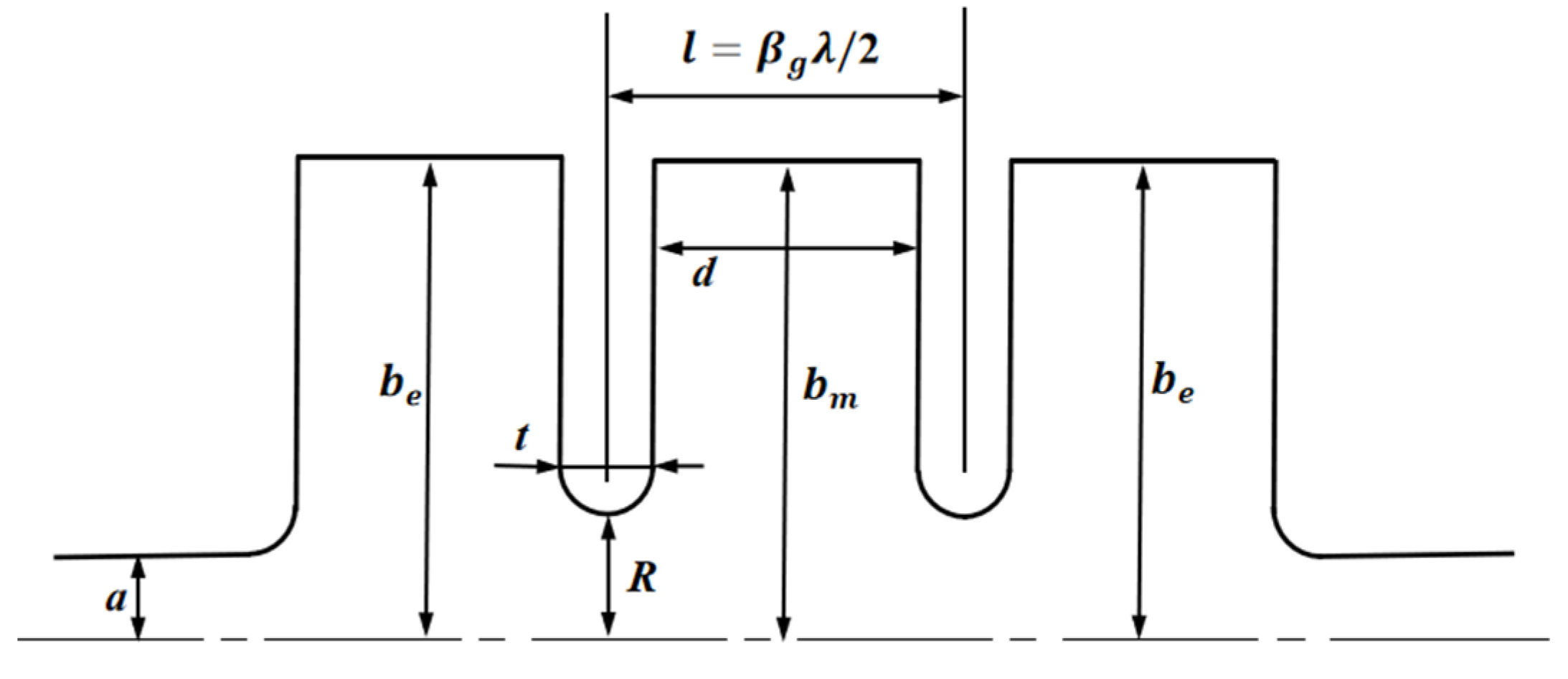




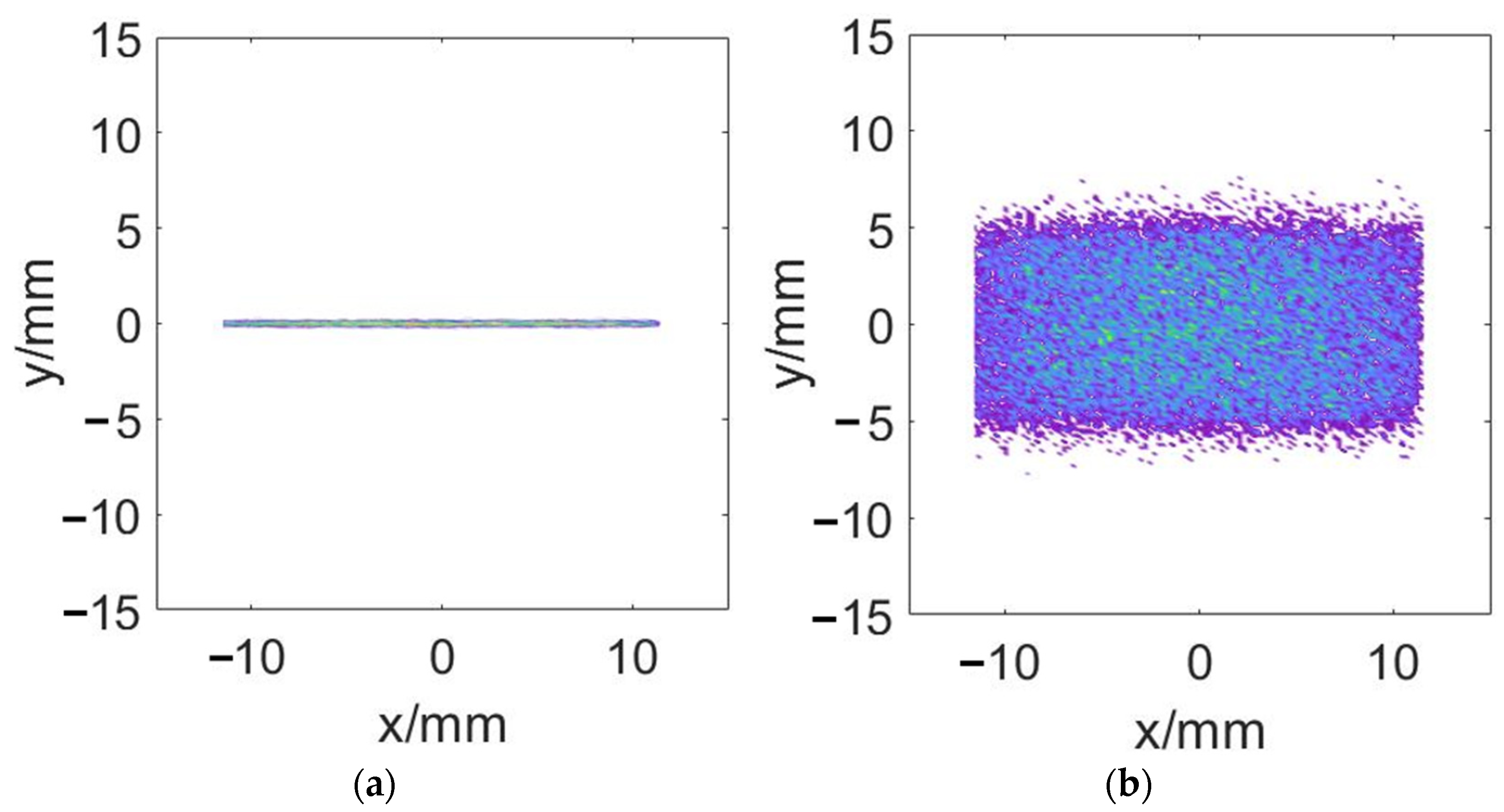
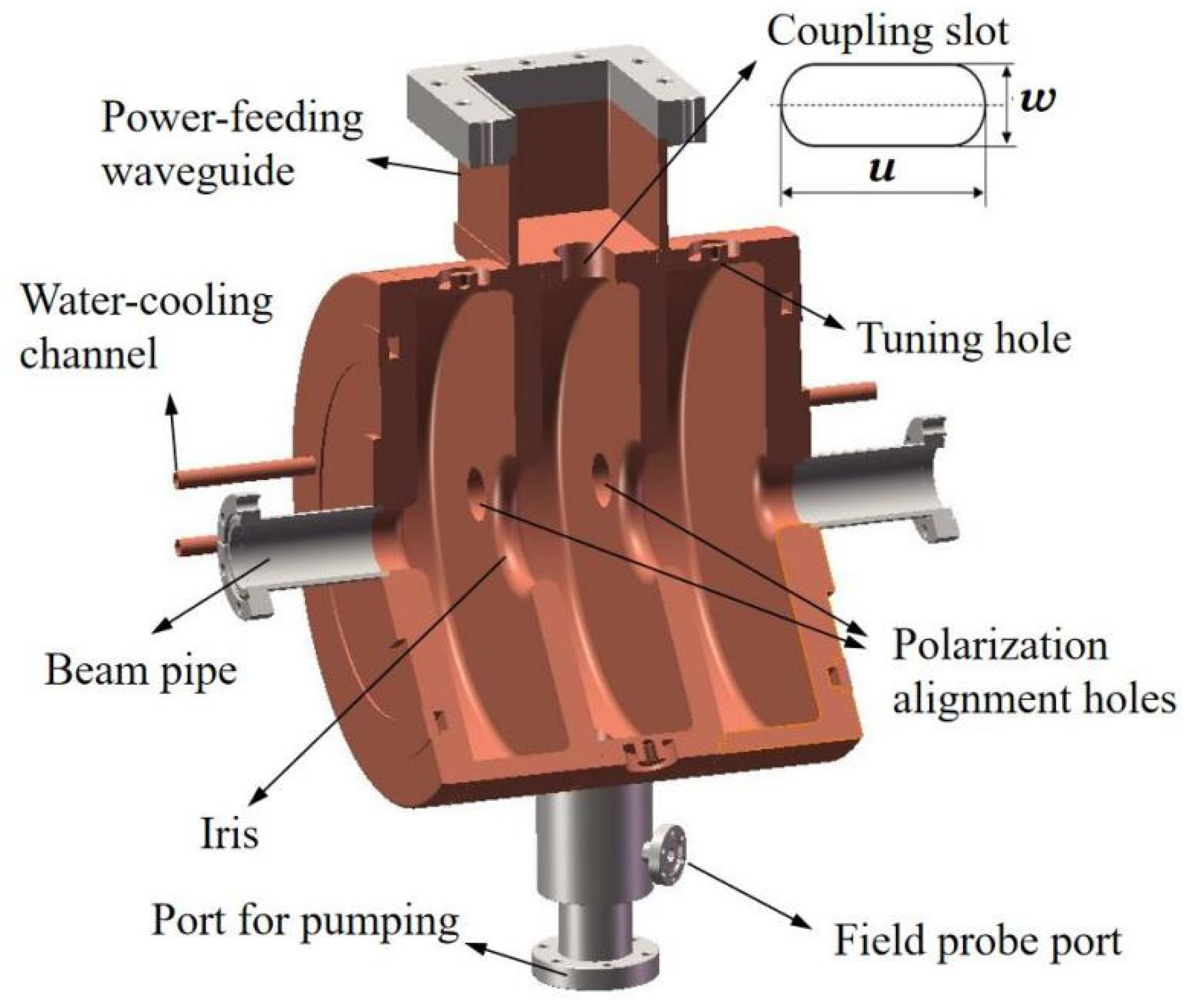

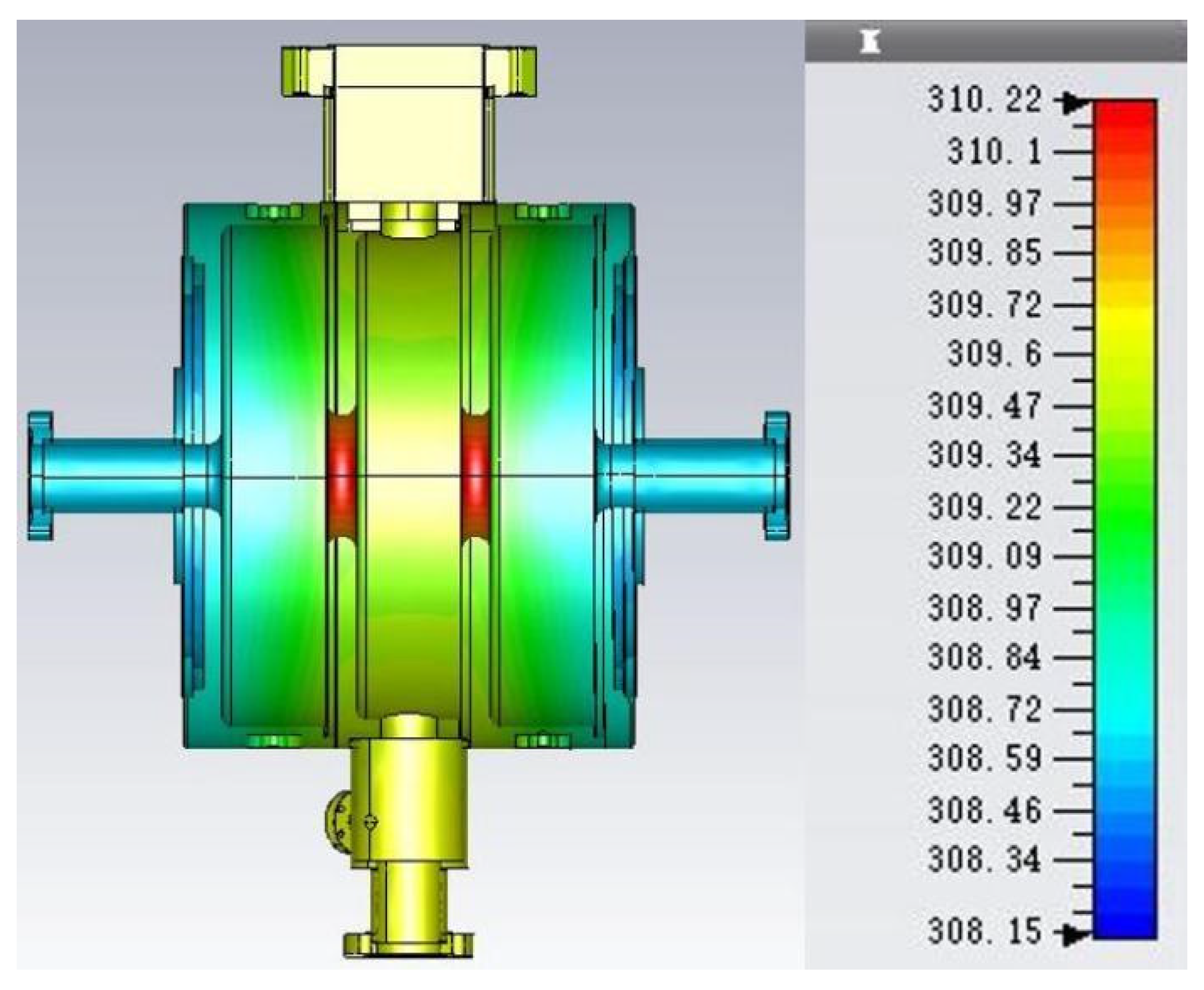

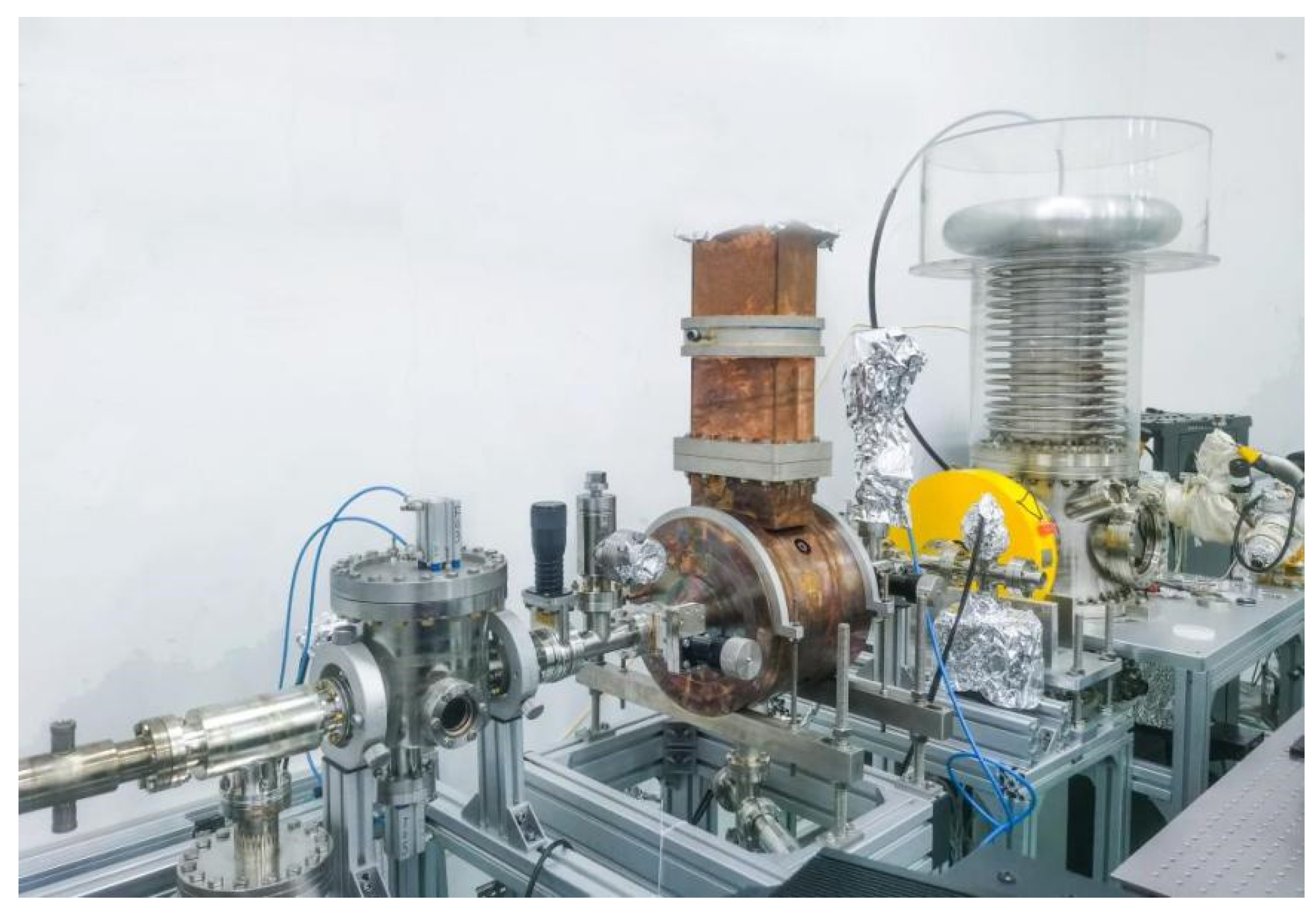
| Parameters | bm | be | d | t | R | a |
|---|---|---|---|---|---|---|
| Value | 132.29 | 136.14 | 57.24 | 16 | 33 | 17.5 |
| Parameters | Design Value |
|---|---|
| Beam energy E [keV] | 150 |
| Operation frequency f [MHz] | 1300 |
| Transverse shunt impedance [MΩ] | 0.98 |
| Quality factor | 19,500 |
| RF input power P [kW] | 2.6 |
| Deflecting voltage [kV] | 50 |
| Expected temporal resolution [fs] | <200 |
| The frequency of π-mode in y-direction [MHz] | 1299.93 |
| The frequency of π/2-mode in y-direction [MHz] | 1312.69 |
| The frequency of 0-mode in y-direction [MHz] | 1335.19 |
| The frequency of π-mode in x-direction [MHz] | 1311.33 |
| The frequency of π/2-mode in x-direction [MHz] | 1317.71 |
| The frequency of 0-mode in x-direction [MHz] | 1352.87 |
| Bunch Charge/fC | Solenoid Focus Intensity/Gauss | Bunch-Length Actual Value/ps | Simulated Value (Resolution)/ps | Energy Increase/keV | Energy Spread |
|---|---|---|---|---|---|
| 50 | 214 | 6.28 | 6.31 (0.59) | 1.5 | 1.32% |
| 100 | 215 | 6.50 | 6.55 (0.60) | 1.5 | 1.37% |
| 200 | 218 | 6.93 | 6.99 (0.65) | 1.5 | 1.42% |
| 500 | 224 | 8.10 | 8.17 (0.88) | 1.5 | 1.86% |
| End Wall Thickness/mm | Largest Deformation/mm | Frequency Drift/kHz |
|---|---|---|
| 10 | 0.0609 | −69.19 |
| 15 | 0.0266 | −33.57 |
| 21 | 0.0142 | −19.55 |
| 23 | 0.0119 | −16.75 |
| 25 | 0.0101 | −14.48 |
Publisher’s Note: MDPI stays neutral with regard to jurisdictional claims in published maps and institutional affiliations. |
© 2022 by the authors. Licensee MDPI, Basel, Switzerland. This article is an open access article distributed under the terms and conditions of the Creative Commons Attribution (CC BY) license (https://creativecommons.org/licenses/by/4.0/).
Share and Cite
Xu, Z.; Wang, F.; Tan, T.; Liu, Y.; Huang, S.; Quan, S. Development of 1.3 GHz Medium-β (β = 0.634) Disk-Loaded Deflecting Cavity for 150 keV Electron Beam. Appl. Sci. 2022, 12, 9243. https://doi.org/10.3390/app12189243
Xu Z, Wang F, Tan T, Liu Y, Huang S, Quan S. Development of 1.3 GHz Medium-β (β = 0.634) Disk-Loaded Deflecting Cavity for 150 keV Electron Beam. Applied Sciences. 2022; 12(18):9243. https://doi.org/10.3390/app12189243
Chicago/Turabian StyleXu, Zhongxiang, Fang Wang, Tao Tan, Yunqi Liu, Senlin Huang, and Shengwen Quan. 2022. "Development of 1.3 GHz Medium-β (β = 0.634) Disk-Loaded Deflecting Cavity for 150 keV Electron Beam" Applied Sciences 12, no. 18: 9243. https://doi.org/10.3390/app12189243
APA StyleXu, Z., Wang, F., Tan, T., Liu, Y., Huang, S., & Quan, S. (2022). Development of 1.3 GHz Medium-β (β = 0.634) Disk-Loaded Deflecting Cavity for 150 keV Electron Beam. Applied Sciences, 12(18), 9243. https://doi.org/10.3390/app12189243





